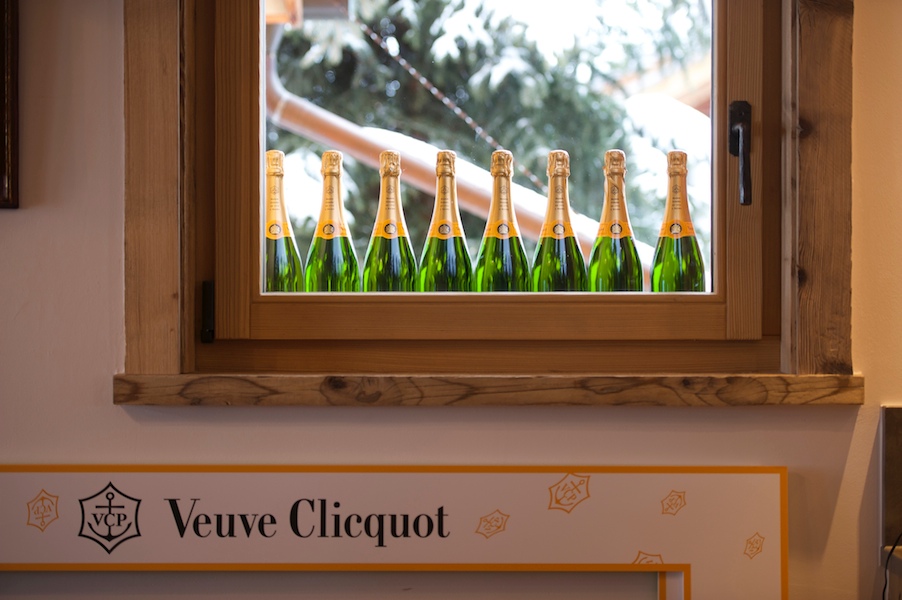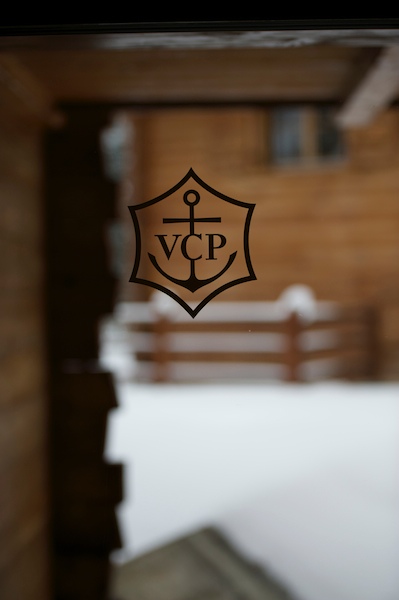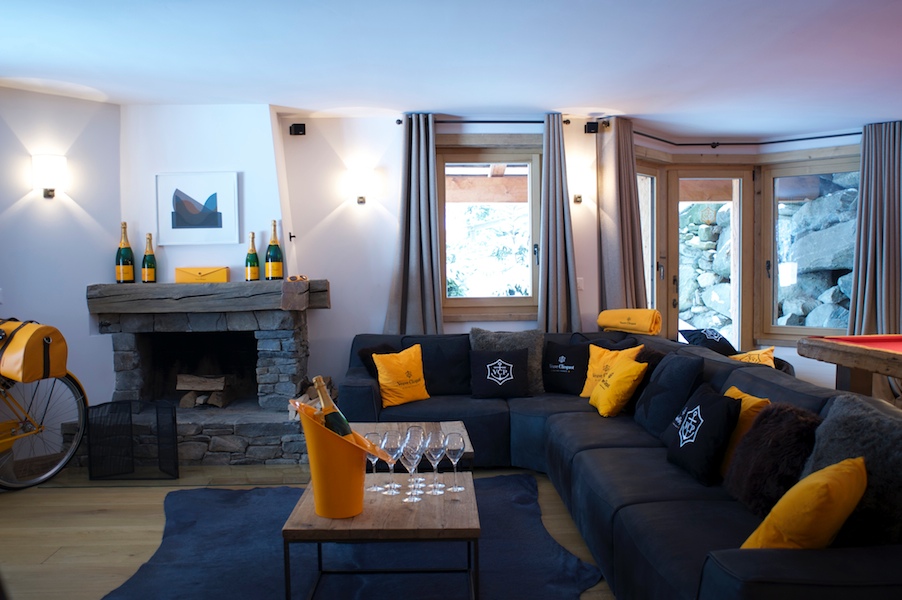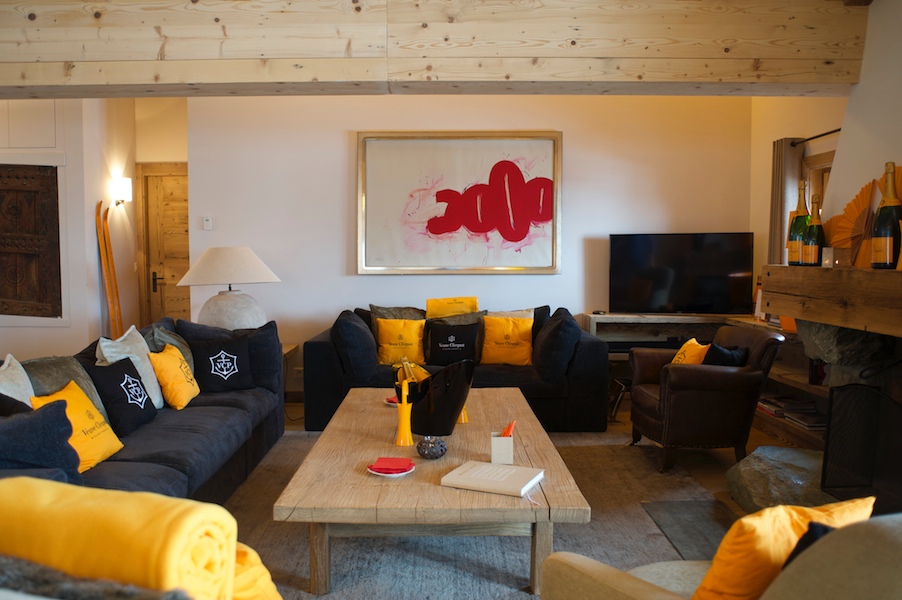The approach of Veuve Clicquot is an intimate one – it’s consumed on special occasions. It’s about togetherness with special people. It’s for a happy few in the know. Not necessarily because it’s your 40th birthday, not necessarily for a special moment in time, a bottle of Clicquot can be opened any time. A lifestyle approach.
NoéMie Schwaller sat down with the brand’s Marketing Director Marie-Laure Trichard at their event venue ‘Le Chalet Clicquot’ in Switzerland’s Verbier.
Marie-Laure, how are you today?
It’s great being here. I feel so good in this chalet; I could just stay here.
I think we all think that.
Yes, there’s no other way to feel in this place.
As part of the Louis Vuitton Moët Hennessy group, you run your own comprehensive portfolio of exclusive Champagnes, wines and spirits. From your experience, what are the advantages of being part of such a big luxury group?
The brand is central, the brand is key, and doing marketing is a big advantage. The idea is to capitalise on these fantastic brands we have in our portfolio because many of them are more than a hundred years old. It’s all about building long-term; that’s really important when you work in marketing. From what I’ve seen, it really makes a difference to your competitors when the focus is on the brand, as there’s a wish to keep the approach of ‘maison’ for each brand to maintain its strong identity and avoid lookalikes. When different brands of different origins come together in a group, at some point they tend to match. Here, the idea is to keep them unique and competitive, to keep their DNA, their essence. That, to me, is the main point of being in this luxury group.
You said it’s important to keep the DNA, but you’ve also said that, at the moment, the direction you want to go in with Veuve Clicquot is younger and more fun.
Yes. This move and change is operated from the maison, meaning it’s a global approach to evolve and to try to rejuvenate the brand. It’s actually not about changing the brand but adjusting the expression of how it’s coming to life. That’s what the maison wants to do and it has developed the new brand signature ‘Let Life Surprise You’ for, which is bringing this joy to the world with some new words to embrace something younger. It’s always about innovation, creativity and the fantastic savoir-faire of Champagne – just that the expression is changing slightly to bring about this rejuvenation.
How are you planning to target the younger market?
This chalet is part of it and important in the approach. The idea is to succeed in making a stronger impact, and that’s why we have quit the partnerships we used to have. We used to be involved in the Omega Masters and the Polo in St.Moritz, which are great events but not giving enough impact to the target. That’s why we decided, after years of partnership, to start this new, 360-degree approach instead. The chalet is a part of it – a place where customers will be invited to live the experience and identity of the brand. Whether B2B or B2C; some people just come for the experience and some as consumers. The chalet is the communication part of the programme ‘Clicquot In The Snow’ that is spread around the country. We’ve developed a branded cabin of them, and whether you’re in a ski resort or in a city, you’ll find them in or outside bars, where we have our target clients, creating some engagement with the brand. Inside you can hide your glass, so it’s an extension of the bar. You’ll have girls doing animation games with people taking pictures and the best will win a stay in the chalet. The idea is to embrace with different angles and get visibility – in department stores like in Manor as well.
So the cabins will be set up in cities and ski resorts for people to climb in?
Yes, it’s just like a photo booth. You can go in to take photos or just have a glass of Clicquot. We’re thinking that it would be a nice visual experience of the mountains and the yellow colour of Clicquot. It immediately brings this sense of joy, uniqueness and something truly special. We have the cabin, and with it visibility. There was a broadcast on the 7.30pm news explaining the concept of après-ski; having a drink outdoors after skiing still in your gear and you can see the Clicquot cabin there. The idea is to have people talking about it to bring this kind of rejuvenation to the brand so that we can bring in the younger crowd as much as the existing consumers, who might be older, but they love the brand and they’re still engaged. People are very engaged with the brand.
You mentioned this photo contest. I assume this is also going onto social media.
Yes. We’re working with the maison on that. The maison is helping us with Facebook and Instagram. Everything is sent to the maison to do the selection and then it will be spread digitally, which is key for the target audience of course.
Was it difficult for you to decide on where you wanted to place the twelve cabins you have all over Switzerland?
Not really. We work with resellers and the brief was clear: We needed a place with a young crowd. It’s easy for them to see and envision the place. The only constraint was to find a place with enough room and then to negotiate how to place it. Creating a nice atmosphere and to some animation for the premise, the bars, the department stores, which is not the peak time of conception but important nevertheless. We are thinking of building a chalet next year somewhere else, probably in the German part of Switzerland because we want to have a good coverage of the country. The concept is going to continue.
Still or sparkling?
My water? Still, because I have the sparkles in the wine.
How do you define luxury and how does it impact the events you endorse?
Luxury starts with a product of indisputable quality. That’s the key thing. Secondly, it’s about the savoir-faire, the great craftsmanship depending on the product. That’s the basis of luxury. Then of course it depends on the way we operate, what we do, attention to details, uniqueness as well as innovation and creativity. When you see it today, luxury is very creative, so that’s the angle on how to manage a brand that’s over 200 years old; to keep up to date, and to still be vibrant and desirable. To me, it’s the balance of all these factors that makes it luxury. What level do we place it on? We decided on a luxury chalet for people to live the experience and the brand. All the decor you see here is bringing the creativity, joy and expression of the brand to life, but you have to present quality and hospitality at the level of the brand. That’s an important balance.
As marketing director for the company in Switzerland you have to make sure that its core values and ideas are communicated and promoted diligently. What are your biggest challenges?
I previously worked with the maison and marketing globally, so I understand what they want to achieve, because I’ve done the other side of it. When I do something with my team, I have to make sure we do it properly, that we don’t try to reinvent things but just put the creativity into the execution and into what we want to express. That’s the main challenge and risk. It’s about focusing on the message and then being creative about how we bring it to life. That’s what’s expected of us. It’s about having creativity in the right place, not to reinvent and create new stories, but to be unique and consistent around the world.
Veuve Clicquot has no ambassador, yet the world today is very celebrity driven. Is that not something you want to endorse?
I wouldn’t think so, but that’s a decision on a maison level and I don’t have any say in that. Maybe one day they’ll say it’s important to have an ambassador, but for now, I don’t think it’s necessary. The focus is on social events in different places around the world. People are creating desirability by drinking Clicquot. This is what the brand needs more than some ambassador.
Veuve Clicquot is over 250 years old if I’m not mistaken?
I need to do some calculations… 243.
High-end fashion has been synonymous with luxury since the very conception of the term. Does the premium Champagne, wine and spirit sector go through similar economic shifts as fashion? Do you feel the effect of the economic crisis or the changes of seasons? Is that something you use also for your house?
We’re actually very much in opposition to fashion. We have a product that has existed for almost 250 years. Champagne and wine evolve with time, the consumer and palette change. When you look at the range of products it’s pretty short and has remained consistent, though of course there have been some shifts. 200 years ago people drank very sweet Champagne, but not so much today, where it’s brut. That’s the reason why we create this collection around the product because the product itself is very stable. It’s fascinating when you look at it: it’s been the same product over centuries in a way. We are so different from luxury in fashion, we don’t have an increase in production or changes from year to year. A move from two a year, to four a year, to sixteen a year. It’s already done. For us, it’s the opposite. We do some animation to tell about brands which are so rich in stories – linked with history, wars, Napoleon and so on. If you think about the product itself, a bottle of Clicquot, it takes 30 months from the time the wine is in the bottle to putting it out on the market. I’m not even talking about the 10 years it’s in the cellar, which is the lead time, meaning developing something new takes a few years and it’s very likely that I will never finalise it. We live a time that’s so far from the speed of fashion. The creator of the wine is just the opposite, it’s about keeping consistency from one bottle to the next. To ensure that any bottle of Clicquot is the same as the other. It’s not about creating a unique piece, but the same. That’s the magic and difficulty.
Interview: NoéMie Schwaller











